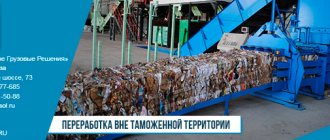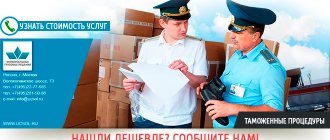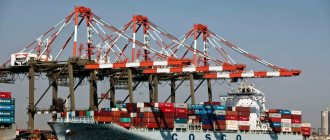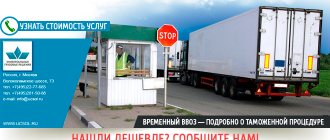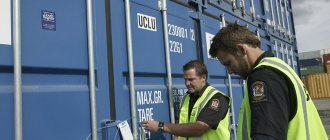HomeCustoms clearanceCustoms regimes Temporary export
Temporary export - the procedure for the temporary export of goods, according to the Customs Code of the EAEU, implies the possibility of exporting certain categories of material assets for a certain period. In this case, customs duties and taxes are not charged and are determined by the Federal Law (Chapter 34) and the Customs Code of the EAEU (Chapter 30) (previously: the Customs Code of the Customs Union (TC CU, Chapter 38)).
The code for the customs procedure for temporary import is EC23, which is indicated when filling out column 1 of the customs declaration by a legal entity or individual entrepreneur.
Column 1 consists of three cells and is filled out as follows:
|
More details about filling
Contents of the customs procedure for temporary export and in what cases it is applied
The customs procedure of temporary export makes it possible to use goods abroad within a specified period, with their subsequent return back, without paying customs duties and without applying non-tariff regulation measures. But this procedure is only suitable if customs can unambiguously identify the goods and record the fact of its export and import. This implies a mandatory search.
This customs procedure can be used for almost any goods and their groups, but there are exceptions.
Attention! The following cannot be placed under the procedure: food, drinks, semi-finished products, alcohol, tobacco products, raw materials and consumables, samples, except those intended for advertising or exhibitions, exported in single copies. Waste, including industrial waste, cannot be placed under the procedure. It is prohibited to export goods that are subject to legal restrictions.
Temporary removal is usually used for:
- Sports equipment necessary for competitions;
- Goods for exhibitions, conferences, seminars;
- Demonstration equipment;
- Any vehicles;
- Musical instruments;
- Theater props;
- Costumes for theatrical tours;
- Everything you need for filming and sports events;
- Paintings and other art objects for exhibitions.
A very convenient form of temporary export is the Carnet ATA passport . It is decorated by musical and theatrical groups, sports teams, and museums. The Carnet-ATA passport is valid in 78 countries and allows you to:
- Avoid customs paperwork;
- Avoid customs duties;
- Export goods to 78 countries for 1 year.
List of countries using the ATA Carnet
- Australia (AU)
- Austria (AT)
- Albania (AL)
- Algeria (AL)
- Andorra (AD)
- Bahrain (BH) exhibitions and fairs only
- Belarus (BY)
- Belgium (BE)
- Bulgaria (BG)
- Bosnia and Herzegovina (BA)
- Brazil (BR)
- Great Britain (GB)
- Hungary (HU)
- Germany (DE)
- Gibraltar (GI)
- Hong Kong (HK)
- Greece (GR)
- Denmark (DK)
- Israel (IL)
- India (IN) only exhibitions and fairs
- Indonesia (ID)
- Iran (IR)
- Ireland (IE)
- Iceland (IS)
- Spain (ES)
- Italy (IT)
- Kazakhstan (KZ)
- Canada (CA) except professional equipment
- Qatar (QA) exhibitions and fairs only
- Cyprus (CY)
- China (CN)
- Korea (KR)
- Cote d'Ivoire (CI)
- Latvia (LV)
- Lebanon (LB)
- Lithuania (LT)
- Luxembourg (LU)
- Mauritius (MU)
- Madagascar (MG)
- Macau (MO) exhibitions and fairs only
- Macedonia (MK)
- Malaysia (MY)
- Malta (MT)
- Morocco (MA)
- Mexico (MX)
- Moldova (MD)
- Mongolia (MN)
- Netherlands (NL)
- New Zealand (NZ)
- Norway (NO)
- United Arab Emirates (AE) exhibitions and fairs only
- Pakistan (PK)
- Poland (PL)
- Portugal (PT)
- Russia (RU)
- Romania (RO)
- Senegal (SN)
- Serbia (CS)
- Singapore (SG)
- Slovakia (SK)
- Slovenia (SI)
- USA (US) except exhibitions and fairs
- Thailand (TH)
- Tunisia (TN)
- Türkiye (TR)
- Ukraine (UA)
- Finland (FI)
- France (FR)
- Croatia (HR)
- Montenegro (ME)
- Czech Republic (CZ)
- Chile (CL)
- Switzerland (CH)
- Sweden (SE)
- Sri Lanka (LK)
- Estonia (EE)
- South Africa (ZA)
- Japan (JP)
The period for export of goods is not regulated by law and is established at customs based on the application, the purpose of export and the type of goods. The product must be returned in its original condition before the expiration date. Minor wear due to use and transportation is acceptable. Repairs made to maintain operability are possible, but not major and not for modernization.
Temporary removal can be completed by placement under the following procedures:
- Re-import
- Export
- Processing outside the customs territory
If violations are detected: terms of export or replacement of goods, administrative liability arises.
Do you need to complete a temporary import procedure? - We will help you!
Eurasian Economic Commission
Article 285. Contents of the customs procedure for temporary exportTemporary export is a customs procedure in which goods of the Customs Union are exported and used for a specified period outside the customs territory of the Customs Union with full exemption from payment of export customs duties and without the use of non-tariff regulation measures, followed by placement under the customs procedure of re-import.
Goods placed under the customs procedure of temporary export and actually exported from the customs territory of the Customs Union lose their status as goods of the Customs Union.
Article 286. Conditions for placing goods under the customs procedure of temporary export
1. Placement of goods under the customs procedure of temporary export is permitted provided that it is possible to identify the goods placed under this customs procedure upon subsequent completion of the customs procedure of temporary export.
Identification of goods is not required in cases where, in accordance with international treaties of the member states of the Customs Union, replacement of temporarily exported goods is allowed.
2. Placement under the customs procedure of temporary export is not allowed:
1) food products, drinks, including alcohol, tobacco and tobacco products, raw materials and semi-finished products, consumables and samples, with the exception of cases of their export in single copies for advertising and (or) demonstration purposes or as exhibition exhibits or industrial designs;
2) waste, including industrial waste;
3) goods prohibited for export outside the customs territory of the Customs Union.
Article 287. Restrictions on the use and disposal of temporarily exported goods
1. Temporarily exported goods must remain in unchanged condition, except for changes due to natural wear and tear or natural loss under normal conditions of transportation (shipment), storage and (or) use (operation).
2. It is permitted to carry out operations necessary to ensure their safety, including repair operations (with the exception of major repairs and modernization), maintenance and other operations necessary to maintain goods in normal condition, provided that the goods are identified by the customs authority when they are re-imported.
Article 288. Time limit for temporary export of goods
1. The period for temporary export of goods is established by the customs authority based on the declaration of the declarant based on the purposes and circumstances of such export, except for the case provided for in paragraph 2 of this article.
At the written request of the declarant, the period for temporary export of goods may be extended by the customs authority, taking into account paragraphs 2 and 3 of this article.
2. For certain categories of goods, depending on the purposes of their export outside the customs territory of the Customs Union, as well as for certain types of goods, the re-import of which during temporary export is mandatory in accordance with the legislation of the member states of the Customs Union, the legislation of the member states of the Customs Union Time limits for the temporary export of such goods may be established.
(clause 2 as amended by the Protocol dated April 16, 2010)
3. In the event of transfer to a foreign person of the right of ownership of temporarily exported goods, in respect of which the legislation of a member state of the Customs Union does not require their return to the territory of this state, the period for the temporary export of these goods is not subject to extension, and these goods are subject to placement under the customs procedure export taking into account the second part of paragraph 1 of Article 243 of this Code.
(clause 3 as amended by the Protocol dated April 16, 2010)
Article 289. Completion of the customs procedure for temporary export
1. The customs procedure for temporary export ends before the expiration of the temporary export period by placing temporarily exported goods under the customs procedure for re-import in the manner and under the conditions provided for by this Code.
The customs procedure for temporary export may be completed before the expiration of the temporary export period by placing temporarily exported goods under the customs procedures of export, processing outside the customs territory or temporary export without actually presenting them to the customs authority in the manner and on the conditions provided for by this Code, except in cases where in accordance with the legislation of the member states of the Customs Union, temporarily exported goods are subject to mandatory re-import into the customs territory of the Customs Union.
2. Temporarily exported goods may be placed under the customs procedure of re-import or under another customs procedure in one or more batches.
Article 290. Origin and termination of the obligation to pay export customs duties and the deadline for their payment in relation to goods placed (placed) under the customs procedure of temporary export
1. The obligation to pay export customs duties in respect of goods placed under the customs procedure of temporary export arises for the declarant from the moment of registration of the customs declaration by the customs authority.
2. The obligation to pay export customs duties in respect of goods placed (placed) under the customs procedure of temporary export is terminated for the declarant:
1) upon completion of the customs procedure for temporary export in accordance with paragraph 1 of Article 289 of this Code;
2) in the cases specified in paragraph 2 of Article 80 of this Code.
3. If the customs procedure for temporary export is not completed before the expiration of the temporary export period in accordance with paragraph 1 of Article 289 of this Code, with the exception of destruction (irretrievable loss) due to an accident or force majeure or as a result of natural loss under normal conditions of transportation (shipment) and storage , use (operation), the deadline for payment of export customs duties is considered to be the day of expiration of the temporary export period established by the customs authorities.
4. Export customs duties are subject to payment in amounts corresponding to the amounts of export customs duties that would be payable when placing goods under the customs procedure of export, calculated on the day of registration by the customs authority of the customs declaration submitted for placing goods under the customs procedure of temporary export.
Article 291. Features of placing temporarily exported goods under the customs export procedure
1. When placing temporarily exported goods under the customs export procedure, the customs value of goods and (or) their physical characteristics in physical terms (quantity, weight, volume or other characteristics), rates of export customs duties and exchange rates established in accordance with the legislation of the state - member of the Customs Union, are determined on the day of registration by the customs authority of the customs declaration submitted to place goods under the customs export procedure.
2. Interest is paid on the amounts of export customs duties paid when placing goods under the customs procedure of export, as if in respect of these amounts a deferment was granted for their payment from the date of registration by the customs authority of the customs declaration submitted for placing goods under the customs procedure of temporary export, calculated in the manner established by the legislation of the member states of the Customs Union.
Rules and features of registration of temporary export
Individuals can use the temporary export procedure only for goods intended for personal consumption (except for commercial shipments).
In this case, payment of customs duties, taxes and other payments is not required. For example, you can place a car used for personal purposes under the temporary export procedure. It is prohibited to use this procedure in relation to goods for which restrictions and prohibitions apply in the territory of the EAEU. A legal entity or individual entrepreneur can place goods under the temporary export procedure if the main condition is met: the presence of all documents established by law. Also, for some categories of goods, payment of customs export duties and other payments is provided. In addition, restrictions and prohibitions for certain goods and their groups must be observed.
Required documents
In accordance with the order of the Federal Customs Service of Russia dated April 25, 2007 No. 536, in addition to the declaration, the following documents and information are additionally submitted under the temporary import regime:
- documents for the purpose of temporary import of goods;
- information about the identification characteristics of goods;
- documents and information justifying the application of a full conditional exemption from duties and taxes;
- an obligation to re-export temporarily imported goods, drawn up in any written form, including documents confirming the availability of security for payment of payments;
- plans and programs for carrying out activities using goods placed under the temporary import regime;
- statement on the expected timing of temporary import of goods;
- documents indicating compliance with the requirements of the previously declared customs regime.
Conditions for placing goods under the temporary export procedure
The main condition for placing under the temporary export procedure is the ability to identify the goods at customs. If customs cannot unambiguously identify the goods and record the fact of its export and import, then it cannot be placed under the procedure. This implies a mandatory inspection. Compliance with the validity period established by customs for which the temporary export of goods will be carried out.
Compliance with restrictions related to maintaining the unchanged type of product. Only wear and tear associated with use and transportation is acceptable.
When registering temporary export of such goods, the declarant must have a declaration, as well as a package of other documents necessary for this procedure. Such goods must be easily identifiable by legal means and not subject to prohibitions and restrictions. When exported, they lose their status as EAEU goods. In most cases, the payment of duties and fees is not established. But, if the legislation regarding a given product or situation states otherwise, then the declarant is obliged to pay the necessary taxes, duties or make other payments.
For most goods and their groups there are no specific time limits for temporary export. At the same time, the customs authority, depending on the purposes of export and the destination of the goods themselves, may set certain deadlines for this procedure. If necessary, the declarant can extend its validity by filing a corresponding application with customs officers. In addition, the option of transferring such goods to foreign citizens and other cases of non-return is possible. In this case, such goods will be subject to the export procedure.
Temporarily exported goods must be kept outside the territory of the customs union in an unchanged condition and form. The only exceptions are their repair and modernization, as well as natural aging.
The temporary export procedure can be completed either at the end of the established period or due to the transfer of goods under another customs procedure, for example, export.
- Documents and information for completing the temporary export procedure (EC 23)
- List of documents for registration of an individual at customs (View)
- List of documents for registration of a Legal entity at customs (View)
- List of documents for registration of an individual entrepreneur at customs (View)
- List of documents for registration of goods and cargo under the customs procedure of temporary export (View)
Our company’s specialists provide assistance in preparing documents and registration - placing exported goods under the temporary export procedure. Our employees are ready to advise clients on what documents will be required in each specific case.
Processing outside the customs territory
Processing outside the customs territory is, in accordance with Article 252 of the Customs Code of the Customs Union, a customs procedure in which goods of the customs union are exported from the customs territory of the customs union for the purpose of carrying out processing operations outside the customs territory of the customs union within a specified period of time with a full conditional exemption from payment of export taxes. customs duties and without the use of non-tariff regulation measures with the subsequent import of processed products into the customs territory of the Customs Union.
Typically, this procedure is used when it is necessary to repair or replace it with similar equipment with identical characteristics.
Operations for processing goods in the customs procedure for processing outside the customs territory include:
- processing or processing of goods in which the goods lose their individual characteristics;
- manufacturing of goods, including installation, assembly, disassembly and fitting;
- repair of goods, including its restoration, replacement of components.
The period for processing goods outside the customs territory cannot exceed 2 (two) years. With the permission of the customs authority, it is allowed to replace processed products with foreign goods that, in their description, quality and technical characteristics, coincide with processed products, if the processing operations involve repairs, as well as when moving goods by pipeline transport.
If the replacement of processed products with equivalent foreign goods is permitted, the import of these foreign goods is permitted before the export of goods of the customs union outside the customs territory of the customs union. But in practice, this article is not applied, because there is no order. In addition, if the replacement of processed products occurs on a paid basis, then the procedure for processing goods outside the customs territory ends with the procedure for release for domestic consumption. Otherwise (free replacement - guaranteed repair), the procedure for processing goods outside the customs territory ends with the re-import procedure. The rules for paid replacement are specified in Decree of the Government of the Russian Federation of December 30, 2011 N 1239.
Attention, important to know!
If the work (examination, etc.) carried out by the manufacturer is paid, then you are required to pay duty and taxes on the cost of the work. The basis of accrual is the cost of the work performed. At the same time, the final procedure is release for domestic consumption.
Examples and practice of working with a special procedure - Processing outside the customs territory.
What to do if, after importation, defective (faulty) goods were discovered, which the sender is ready to accept back and repair or replace with a similar new product? How to receive duty-free and VAT-free new high-quality expensive goods from abroad as a replacement for a defective one? What are the nuances and features of customs clearance of new foreign goods placed under the re-import customs procedure? To do this, let's look at a specific example.
Example. Russian (Nizhny Novgorod) purchased a product from Germany - a transformer, which is part of the main weaving equipment for the production of fabrics, hereinafter referred to as the product). After import through the Domodedovo airport and customs clearance, the goods were installed in the main equipment, but after 2 days specialists discovered a manufacturing defect in the imported goods. Based on the contract (article “Warranty repairs”) under which the goods were imported, the manufacturer is ready to accept the goods for repair free of charge and, if necessary, repair, adjust or replace with similar new equipment. However, you need to understand that if the manufacturer carries out repairs for a fee, then upon re-import you will need to pay local fees (the accrual basis is the cost of repairs).
If in the end the manufacturer is ready to make free repairs or replace the faulty product, then your sequential operations are as follows:
- It is necessary to draw up a complaint report within the time limits specified in the foreign trade contract for the import of equipment.
.rar file (9 KB)
- Together with the complaint report, a letter of complaint is drawn up to the manufacturer. In this letter, ask the manufacturer to accept the defective product under the contract.
.rar file (8 KB)
- In response to the letter - claim and complaint report, the supplier (Manufacturer) confirms that, in accordance with the terms of the contract, he is ready to accept the faulty product under the terms of FCA Moscow and carry out repairs free of charge. After repairs, send it to Domodedovo Airport on DAT terms (Incoterms 2010).
File .rar (11 KB)
It is very important to pay attention to 2 points:
1) delivery conditions according to Incoterms 2010 must be exactly the same as indicated above, in order not to pay customs duties upon re-import (re-import);
2) First, warranty repairs must be declared, and then, after filing the declaration and release of the goods, if necessary, replacement with a similar new product. Otherwise, you will have to obtain permission for processing outside the customs territory.
Based on Part 6 of Article 259 of Federal Law No. 289FZ
- If the purpose of placing goods under the customs procedure of processing outside the customs territory is their repair, a customs declaration can be used as an application for processing goods outside the customs territory. Otherwise, it is necessary to obtain permission to process goods outside the customs territory. The application review period is 15 days.
- Then, the faulty goods are placed under the customs procedure of processing outside the customs territory. At the same time, additional agreements to the contract (foreign trade agreement) need not be drawn up, because the basis for placement will be the consent of the supplier.
Recommendations for foreign trade participants when placing goods under the customs procedure for processing outside the customs territory:
- To avoid customs inspection, we recommend attaching photographs of the goods in advance, which will indicate the identification characteristics of the goods: serial number, article numbers, date of manufacture, etc.
- Attach the customs declaration (CCD) under which the faulty goods were imported.
- Be sure to indicate the previous customs procedure, for example IM 40, and indicate the correct code according to the classifier of features of the movement of goods.
| Since there are, we offer our own additional features for filling out the customs declaration, customs declaration - processing outside the customs territory. |
- If the goods will not be replaced with similarly new ones, we will immediately go to point 10. Otherwise, we will prepare and draw up documents to obtain permission to replace processed products. In accordance with the order of the Federal Customs Service dated 02/07/2011 No. 217, an application to replace processed products with equivalent foreign goods is submitted after filing the customs declaration and before or after the release of the customs declaration. We recommend submitting an application for a replacement after the release of the customs declaration (placement under there. Processing procedure outside the customs territory), because if necessary, the customs authority has more opportunities to refuse a replacement. In any case, you should receive an answer within 2 days.
- Immediately after the release of the customs declaration, a letter of appeal from the Russian company to the manufacturer is drawn up, which explains the reason for the urgent replacement of the product with an equivalent foreign product. For example, prolonged repairs will lead to losses for the company and the cessation of the activities of a separate production department, and failure to fulfill the company’s obligations to customers will lead to significant losses.
Appeal from a Russian company to the manufacturer for replacement with equivalent foreign goods - In response to the request, an additional agreement to the contract is drawn up, which indicates the consent of the supplier and confirmation that, in accordance with the terms of the contract, he is ready to accept the faulty (defective) product under the terms of FCA Moscow and replace it free of charge with a new equivalent (similar), but serviceable product and send to Domodedovo Airport at your own expense on the terms of DAT Domodedovo Airport (Incoterms 2010). Depending on the terms of the contract, it is necessary to draw up an annex for each shipment, where the terms of Incoterms 2010 should be specified.
Additional agreement and annex to the contract for each shipment sent - On the same day, after the declaration is issued, an application is submitted to replace processed products with equivalent foreign goods on the basis of Part 1 of Article 259 of the Customs Code of the Customs Union, as well as on the basis of the Federal Customs Service order No. 217 dated 02/07/2011. The application indicates the reason for the need to replace the processed product and the necessary additional information about the product.
Application for replacement of processed products with equivalent foreign goods - Within 2 days after submitting the application, we receive a response from customs and permission to replace it (.rar file - 1.6 MB).
- After receiving permission for a replacement and after import, we place the goods under the re-import procedure or after repair, the serviceable goods are imported into Russia within the time limits specified in the declaration issued in the procedure for processing goods outside the customs territory.
Registration of customs procedures for temporary export of cargo and goods
Ours is a customs broker and carries out prompt clearance of the customs procedure for the temporary export of any cargo and goods at any customs office of the Russian Federation:
- At airports
- In seaports
- At railway stations
- At cargo automobile terminals – temporary storage warehouse
- Express postal items
If necessary, we carry out customs clearance of goods in any other customs procedures!
We work with any participants in foreign trade activities:
- Individuals
- Legal entities
- Individual entrepreneurs
We place goods under the customs procedure of temporary export and help to obtain a Carnet-ATA passport.
Temporary export period
When submitting a customs declaration, an application is submitted to the customs authority, where the applicant indicates the goals and deadline. The declaration is marked accordingly. For groups of goods whose re-import is mandatory, a deadline for re-import is established.
If some of the goods are sold to a foreign person and are not required to be re-imported, the extension of the temporary export regime is completed, and the goods are processed under the export regime (EC-10). Some categories of goods cannot be re-registered for export, for example things of cultural value.
Documents for registration of temporary import are determined by Order of the State Customs Committee of the Russian Federation dated December 4, 2003 N 1389.
Time frames and costs for completing the customs procedure for temporary export
The deadline for completing the temporary export procedure is 1 day!
At the same time, the price or cost of clearance - placing goods under the customs procedure for temporary export in our company is the minimum in the market and depends on the place of customs clearance, the participant in foreign trade activities, the type of delivery, the client’s tasks, the quantity and volume of goods being processed. On average, in both directions, including temporary storage, the cost of customs clearance of cargo is:
- For legal entities or individual entrepreneurs delivering cargo by road transport - 65,000 rubles.
- For legal entities or individual entrepreneurs delivering cargo by air - 45,000 rubles.
- Upon presentation of your passport, the ATA carnet costs 1,500 euros.
You need a Carnet-ATA passport - we will issue it within 7 days!
Price and cost of issuing a Carnet-ATA passport: consists of the cost of registration and an insurance premium amounting to 0.3% of the total cost of the goods.
We are ready to become a reliable partner at customs!

